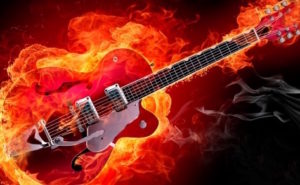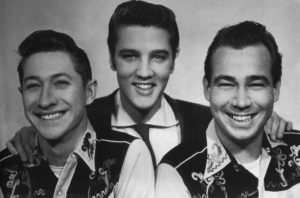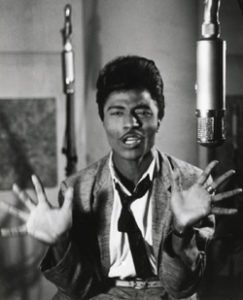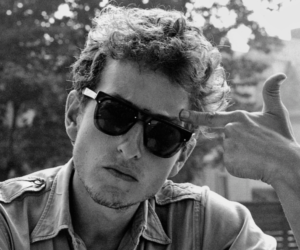Shake, Rattle and Roll
Appeared as the introductory essay to the booklet accompanying Rock and Roll and American Society, Part 1, an audio course I created for the Modern Scholar Series from Recorded Books, 2011. The series was folded by the company before we could record Parts 2 and 3.
For several years, I taught an honors course in the mass media and society, which was about as exciting as it sounded. So one semester I thought, “What the hell – you’re written all this stuff about rock’n’roll, so why not teach a course in it?” So I redrafted that same course and turned it into a rock’n’roll and society class.
 I sent in the course proposal and soon got a note back from the dean of the honors college. He wanted to talk to me. Expecting blowback, I got this: “Cool.”
I sent in the course proposal and soon got a note back from the dean of the honors college. He wanted to talk to me. Expecting blowback, I got this: “Cool.”
Of course the story of rock’n’roll and American Society isn’t just the story of guitar players and record labels and disc jockeys. As you’ll soon find out, rock’n’roll makes a great cultural window into looking at our society.
Elvis Presley brought the music of black and white America together on one seven-inch piece of plastic in the summer of 1954. That was the year of the Supreme Court’s Brown v. Board of Education decision, that set the country on its long path to untangling the separate-but-equal societies created by an earlier version of the Supreme Court. It was a year before the Montgomery Bus Boycott brought Martin Luther King into the national arena, and three years before gun-toting troops had to escort African American students to their classes a Central High School in Little Rock.
We call those great years of rock’n’roll “classic rock” now and television and radio stations are devoted to the music of that era. Those were also the great years of the Civil Rights movement.
Presley isn’t thought of as a “political” artist, but that first single was a Statement because it combined the music of black America with the music of white America. Radio was segregated in 1954, but when Sun Records released that single, Elvis reinterpretation of rhythm and blues led listeners to the original sources. Those liberating radio waves didn’t recognize whether listeners were black or white. The air did not honor Jim Crow laws.

As those laws began crumbling down, so did the barriers to music. In 1955, the year of the bus boycott, African American singer-songwriter Chuck Berry began trying to consciously knock down racial barriers. Using a narrative style that borrow a lot from country and western music – and combining that with a love of the blues – Berry created a distinctive syllable-crammed style with songs about experiences he knew both black and white kids shared. Berry’s songs were about things rarely considered fodder for pop songs: divorce from the kid’s-eye-view (“Memphis”); unappreciated Army veterans (“Too Much Monkey Business”) and statements of black pride (“Brown-Eyed Handsome Man.”). Berry wanted to entertain, but like a lot of rock
and rollers to follow, there was a message in those chords.
Whenever there’s talk of rock and roll’s social consciousness, it often centers on Bob Dylan, who did not begin recording until the 1960s. Yet before Dylan came along, the songs of Chuck Berry and Eddie Cochran made statements about teen-age angst. In “Summertime Blues,” Cochran played both kid and tormenting adult (lowering his voice an octave) in this famous passage:
I asked my congressman and he said (quote),
I’d like to help you son but you’re too young to vote.”
So Dylan did not invent social commentary in popular music. That goes back to the beginning. It’s just that rock and roll embraced the idea more than any other strain of music except folk, and after Dylan came along in the early 1960s, things were never the same in rock and roll. Dylan knocked down walls between folk and rock and upped the ante for songwriters.

Dylan came into rock and roll from the folk music subculture and brought along an understanding of that genre’s long tradition of topical songs. He gained notoriety by singing epic ballads of racial murders and social injustice. When he began playing electric guitar in 1965 and hired a bar band to back him up, his songs – those unyielding demands for truth and honesty – put him at the top of the charts.
These great rock’n’roll artists had an audience. Back then, radio was not as segmented as today, and listeners could hear rock’n’roll and soul and pop on the same station, one song right after the other. The Beatles followed by James Brown followed by Bob Dylan followed by Smokey Robinson followed by Frank Sinatra. Today, radio is so format-split that it’s a lot like the pre- rock and roll era of radio segregation.
So let’s think about the more than half a century of rock’n’roll:
- In the 1950s, the very existence of rock’n’roll was political. With his contradictory sneer and yes-ma’am/yessir manners, Elvis Presley represented something new and different and terrifying to the mothers and fathers of the nation. And African Americas such as Chuck Berry, Fats Domino and (Lord have mercy) Little Richard represented something much of middle America had never seen.
-

Bob Dylan In the 1960s, Bob Dylan used music to chronicle two social movements. His finger- pointing songs about racial injustice were sung at scores of civil rights rallies, and his anti-war ballads were the soundtrack for the campus out-of-Vietnam demonstrations (oddly, though, Dylan didn’t use the word “Vietnam” in a lyric until 1985). To say that every rock artist from the Beatles on down was influenced by Dylan is like saying water is frequently wet.
- In the 1970s, the frightening and rebellious music of the Sex Pistols and the other punk bands was another wave of insurrection – this time, in part, against rock music that had become too corporate. Johnny Rotten and his band raged against the fat, happy rock stars who had once symbolized youth and swagger, but who then committed the sin of aging.
• In the 1980s, 1990s and 2000s, we again heard rock as an expression of anger with social conditions. The music asked whose cultural values were at stake. Rappers and hip- hop artists inspire the same outrage that got Chuck Berry in so much trouble back in the 1950s. (Berry was persecuted by the white establishment and did two years in prison.) A a half century later, rappers brought ghetto anger into white homes. The rappers’ words, delivered in machine-gun cadence, revive all the old rock and roll fears: Obscene … immoral … disgusting … Devil’s Music.
That means rock and roll is still on the job, working for you. If the music isn’t making people mad, it isn’t rock and roll. At least once a decade, rock and roll eats itself, and that process of reinvention is one of the things that makes it so much fun.
We’ve conceived a series of three Modern Scholar courses, of which this is the first. We will not be offering a definitive history of rock’n’roll. It’s doubtful such a thing could be done and make any real sense.
In Part 1, we start at what might be a beginning, and we end around 1960 (though we dip our toes into some music later in the decade, mostly as examples).
Here’s hoping you enjoy the ride.
